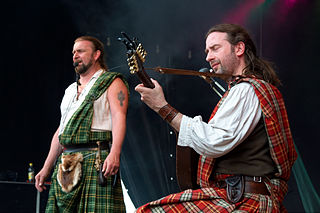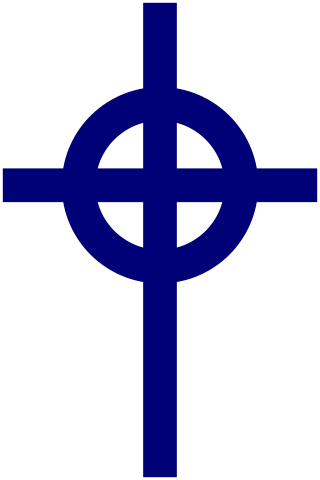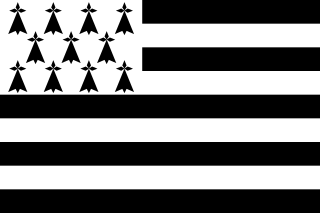History
Bleimor was founded in Paris on 9 January 1946 by Pierre Géraud-Keraod (later founder of the Scouts d'Europe ) and Lizig Géraud-Kéraod, on the model of the Urz Goanag Breiz (Order of the Breton Hope in the Breton language) youth movement for Celtic revival in Brittany, founded in 1943 by Yann-Vari Perrot and Herry Caouissin, on the model of the Welsh movement Urdd Gobaith Cymru (Order of the Welsh Hope in the Welsh language).
The statutes of the Bleimor organization were officially lodged with the Prefecture of Police of Paris in April 1950. The goals of the association were stated as "Practices of Scouting and the activities of cultural expression, dances, choir singing, popular music, dramatic plays", without reference to Scouts de France, nor to the Breton language.
The first bulletin, was published in 1947, specified the objectives of the association as "Christian action, Celtic expression, social service, spiritual, cultural and folk formation of the Rovers, Scouts, leaders and Guides of France of Breton origin".
Bleimor merged into the Federation of European Scouts in 1962. Joseph Chardronnet was chaplain of the organization from 1948 to 1965.
Bleimor's flag was a green field charged with a yellow circle and a Scandinavian-style black cross fimbriated with white, the whole representing a Celtic cross. Rectangular as well as triangular flags were used. The Scout movement also used a white flag with a black cross voided through and seven black ermine spots in the canton. The ermine spots had an unusual art déco pattern (a triangle, one vertical and two horizontal dashes).

Celtic music is a broad grouping of music genres that evolved out of the folk music traditions of the Celtic people of Northwestern Europe. It refers to both orally-transmitted traditional music and recorded music and the styles vary considerably to include everything from traditional music to a wide range of hybrids.

Brittany is a peninsula, historical country and cultural area in the north-west of modern France, covering the western part of what was known as Armorica during the period of Roman occupation. It became an independent kingdom and then a duchy before being united with the Kingdom of France in 1532 as a province governed as a separate nation under the crown.

The Celtic cross is a form of Christian cross featuring a nimbus or ring that emerged in Ireland, France and Great Britain in the Early Middle Ages. A type of ringed cross, it became widespread through its use in the stone high crosses erected across the islands, especially in regions evangelized by Irish missionaries, from the ninth through the 12th centuries.

The Celtic Revival is a variety of movements and trends in the 19th, 20th and 21st centuries that see a renewed interest in aspects of Celtic culture. Artists and writers drew on the traditions of Gaelic literature, Welsh-language literature, and Celtic art—what historians call insular art. Although the revival was complex and multifaceted, occurring across many fields and in various countries in Northwest Europe, its best known incarnation is probably the Irish Literary Revival. Irish writers including William Butler Yeats, Lady Gregory, "Æ" Russell, Edward Martyn, Alice Milligan and Edward Plunkett stimulated a new appreciation of traditional Irish literature and Irish poetry in the late 19th and early 20th century.

The flag of Brittany, a region in the northwest of France, is called the Gwenn-ha-du, which means white and black, in Breton. The flag was designed in 1923 by Morvan Marchal. It is also unofficially used in the department of Loire-Atlantique, although this now belongs to the Pays de la Loire and not to the region of Brittany, as the territory of Loire-Atlantique is historically part of the province of Brittany. Nantes, its prefecture, was once one of the two capital cities of Brittany.

Pan-Celticism, also known as Celticism or Celtic nationalism is a political, social and cultural movement advocating solidarity and cooperation between Celtic nations and the modern Celts in Northwestern Europe. Some pan-Celtic organisations advocate the Celtic nations seceding from the United Kingdom and France and forming their own separate federal state together, while others simply advocate very close cooperation between independent sovereign Celtic nations, in the form of Breton, Cornish, Irish, Manx, Scottish, and Welsh nationalism.

Breton literature may refer to literature in the Breton language (Brezhoneg) or the broader literary tradition of Brittany in the three other main languages of the area, namely, Latin, Gallo and French – all of which have had strong mutual linguistic and cultural influences.

Alan Heusaff, also Alan Heussaff was a Breton nationalist, linguist, dictionary compiler, prolific journalist and lifetime campaigner for solidarity between the Celtic peoples. A co-founder of the Celtic League in 1961, he was its first general secretary until 1984.

Breton nationalism is the nationalism of the historical province of Brittany, France. Brittany is considered to be one of the six Celtic nations.

The Bretons are an ethnic group native to Brittany, north-western France. They trace their heritage to groups of Brittonic speakers who emigrated from southwestern Great Britain, particularly Cornwall and Devon, mostly during the Anglo-Saxon settlement of Britain. They migrated in waves from the 3rd to 9th century into Armorica, which was subsequently named Brittany after them.

The Kroaz Du is a flag of Brittany, used as an emblem of the independent duchy in the late Middle Ages. In the Breton language, kroaz means cross and du means black.

Yann-Ber Kallocʼh was a Breton war poet who wrote in both Breton and French. Similarly to the Welsh poet Hedd Wyn, Kalloc'h was killed in action during trench warfare while serving as a Poilu during World War I. Kalloc'h's death was an equally catastrophic loss to Breton literature.

Perig (Pierre) Géraud-Keraod was one of the founders of the Bleimor Scouting movement in 1946, and later founder of the Scouts d'Europe.

Celtic toponymy is the study of place names wholly or partially of Celtic origin. These names are found throughout continental Europe, Britain, Ireland, Anatolia and, latterly, through various other parts of the globe not originally occupied by Celts.
Common Brittonic, also known as British, Common Brythonic, or Proto-Brittonic, was a Celtic language spoken in Britain and Brittany.
Vefa de Saint-Pierre, born Geneviève de Méhérenc de Saint-Pierre, or Brug ar Menez Du was a Breton explorer, reporter and author, born in Plian, France, on 4 May 1872 and died in Sant-Brieg in 1967.
Pierre-Yves Lambert is a French linguist and scholar of Celtic studies. He is a researcher at the CNRS and a lecturer at the École Pratique des Hautes Études in Celtic linguistics and philology. Lambert is the director of the journal Études Celtiques.

Donatien Laurent was a French musicologist and linguist.
















